
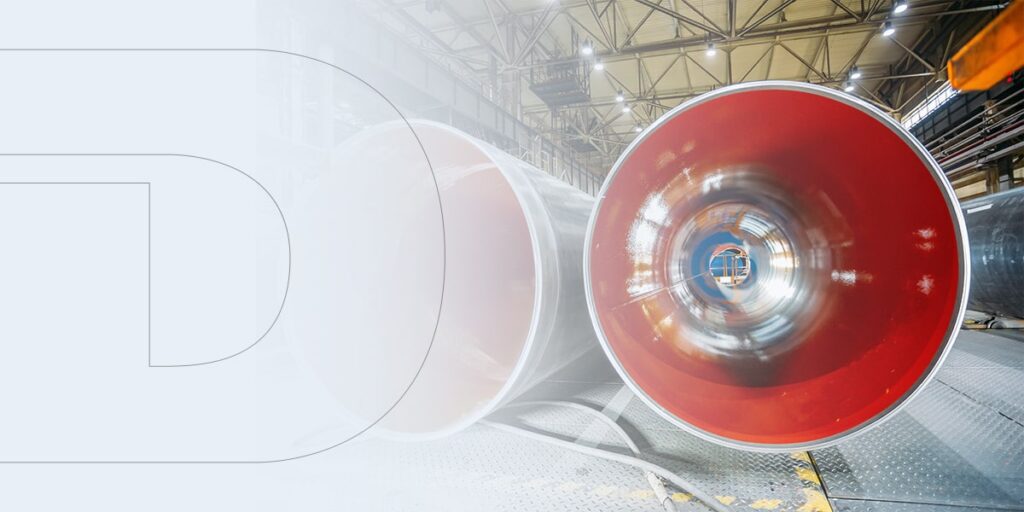
Corrosion and exposure to external contaminants like toxic substances and chemicals can cause pipes to experience a significant loss due to physical damage, reduced productivity, increased replacement components and higher maintenance costs. This is where a protective external pipe coating comes in. When you apply a coating to a pipe, you can decrease these losses to your bottom line. A coating creates a barrier between external environments and metal pipes. A protective layer of coating is essential in industries like construction and aerospace manufacturing.
This guide covers various metal pipe coating types, defines different types of coatings and can help you determine the kind of pipe or tube coating machine you need.
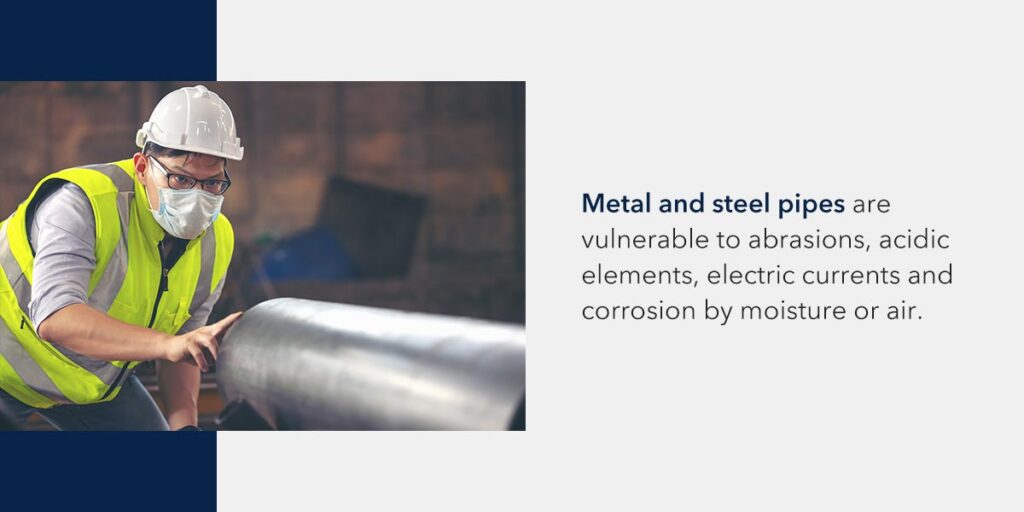
When steel is produced, it starts to oxidize again to its initial state of iron oxide. Metal and steel pipes are vulnerable to abrasions, acidic elements, electric currents and corrosion by moisture or air. These can all lead to disasters like a pipe leak or a steel wall explosion. A protective coating forms a barrier between the surface of the steel and oxygen, which can cause oxidation. Pipes properly treated with coating can benefit from additional protection against corrosion and extended life spans.
External pipe coatings help preserve the metal pipes you work with and ensure their durability. Pipe coatings make pipes stronger and more effective at transporting water, gases and oils. Along with protecting and safeguarding the pipe, metal and steel pipe coatings can mean pipes require less maintenance. Because of all these benefits, there is high demand for good quality pipe coatings.
Metal coating machine manufacturers produce equipment to create different types of coatings. Processes for applying coatings to steel and metal parts include:
Each technique addresses different environments and uses. Aluminum, zinc, lead or powdered stainless steel can pigment coatings. Coated pipes appear clean and smooth, making them look attractive and hygienic.
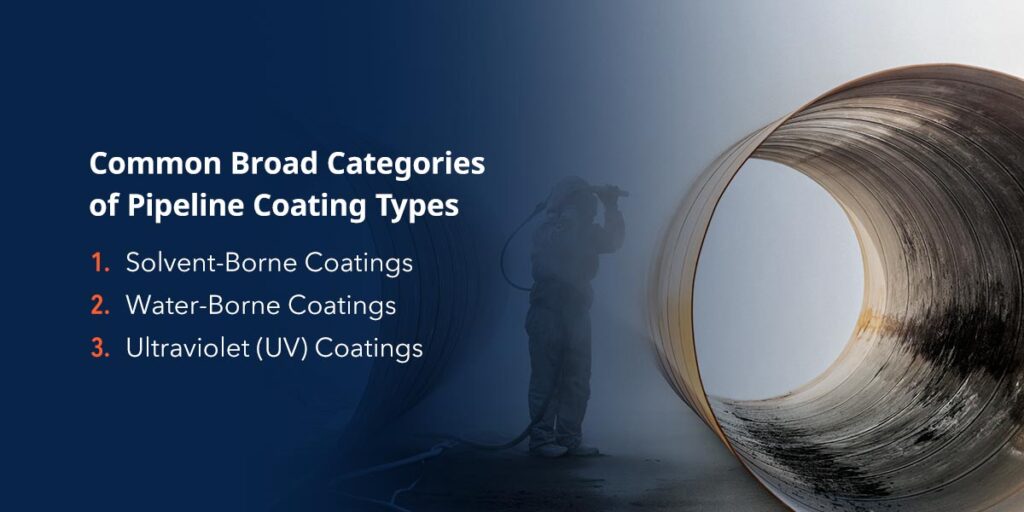
There are three main types of external pipeline coatings — solvent-borne coatings, water-borne coatings and UV coatings. The type of coating that is right for your project depends on the specific circumstances of the job. Each type of coating has its advantages, and they perform differently depending on the situation and conditions.
Sometimes known as solvent-based coatings, solvent-borne coatings are liquid protective layers mainly composed of organic compounds added to the surface of a material to prevent corrosion. Typically, these coatings are more resilient than a water-borne coating. Solvent-borne coatings tend to be better suited to applications in humid environments that prevent water-borne coatings from curing properly.
These coatings cure because of a chemical reaction between the coating and oxygen rather than by water evaporation, which means humidity is less of a factor for this type of coating. However, solvent-borne coatings are also considered less environmentally friendly than water-borne coatings because they often contain volatile organic compounds (VOCs).
Still, solvent-borne coatings are popular for use in harsh conditions. These coatings are less vulnerable to environmental conditions like humidity and temperature during the curing phase, so they are practical in nearly any climate. Other advantages of solvent-borne coatings include:
Water-borne or water-based coatings are another type of pipe coating. Advances in water-borne coatings make it an attractive option for protecting material surfaces. Benefits of a water-borne coating include ease of thinning, lower VOCs and low toxicity. Water-borne coatings have quick drying times and excellent adhesion properties. These coatings can be applied with several different methods, such as flood and wipe, dip and spray.
For workers, evaporation of solvents may be uncomfortable and even hazardous while working in poorly ventilated or confined spaces. As a result, projects that involve railroad tankards and fuel storage tanks use water-based coatings. Water-borne coatings can also lower the concentration of flammable materials in a confined space.
Another one of the major advantages of a water-borne coating is environmental compliance. Many solvents evaporate into VOCs. State, local and national governments often regulate the amount of VOCs businesses are permitted to emit during a certain time. However, water can also be a key component in the corrosion process. Spot rusting could occur if the water comes in contact with the substrate before applying the coating. To prevent this, water-borne coatings should be formulated to draw out the water through a surface film.
Another type of pipe coating is UV, which is photoreactive and instantaneously polymerized when exposed to UV radiation. Typically, the coating cure rate varies depending on the power of the light source, such as how long the coating is exposed to the light and the amount of oxygen in the chamber, as oxygen inhibits surface cure. A UV coating can be applied with flood and wipe equipment or conventional spray. Advantages of a UV coating include:
However, there are also a few disadvantages of UV coatings. This coating tends to be more expensive than other coatings and can sometimes give off a strong odor. Due to the need for replacement UV bulbs, these coatings can come with higher equipment maintenance costs. The UV coating process can also be hazardous, causing sunburn and allergies. With the Dubois Pipe Coater, you can apply 100% solid UV coating to tubes or pipes.
Now that you’re familiar with the three main types of pipe coatings, it’s important to know the specific type of coating you need, as your choice of machine will depend on it.
HPPC is a commonly used coating material in many types of industries. This coating contains a polymer resin combination, including additives, colorants and flow modifiers. HPPC is suitable for pipes in extreme or harsh environmental conditions, such as gas and oil pipelines and metal refineries.
HPPC includes a compound polyethylene to protect pipes during an underground project or transport. The polyethylene component helps maintain the pipe’s quality even when exposed to soils and chemicals. HPPC coatings are best for pipes with smaller circumferences and may not be appropriate for pipes used in construction projects.
Pipes coated with 3LPE or 3LPP include three layers of coating:
The final layer provides durable, tough protection against erosions and corrosion. A 3PLE or 3LPP coating can strengthen a pipe’s electrical resistance, mechanical properties and anti-aging qualities. This coating can also make a pipe waterproof and protect it from heat loss. This means a 3PLE or 3LPP coating offers the advantages of FBE and polyethylene or polypropylene. Benefits of these pipe coating types include:
There are also some disadvantages to these pipe coating types, such as:
HDTLPC combines adhesive layers and powder and contains polyethylene content similar to HPPC. HDTLPC is the final coat on a multi-layered coating. Typical powder and two-layer coatings peel off easily. HDTLPC is more durable and lasts longer. With HDTLPC, steel pipes can maintain their physical shape and form during storage or stacking.
Polypropylene is suitable for deep-sea applications, as these applications have high pressures and temperatures. Polypropylene coatings offer reliability, low water absorption, a high melting point, flexible coating designs and easy, stable processing. Remember that polypropylene is vulnerable to chain degradation due to exposure to UV radiation and heat and may not be the best coating for pipes regularly exposed to direct sunlight.
Another type of pipe coating is fusion-bonded epoxy (FBE). Also referred to as fusion bonding, this coating involves applying heat to a powder coating made from hardening agents and an epoxy-based resin. FBE can be bonded to steel pipe electrostatically via a heating process due to the resin’s thermosetting properties. This makes the coating longer-lasting and more effective.
One of the most efficient application methods involves submerging the preheated material in a fluidized bed for a set amount of time. This helps you achieve the coating thickness you prefer. External and internal surfaces can both be treated with FBE. FBE coatings are commonly used in the following industries and applications:
FBE can be used on pipes that are smaller in diameter and size. An FBE coating offers excellent chemical resistance and dimensional stability with minimal hysteresis. The FBE coating is more resistant to higher temperatures than other types of coating, like HPPC. This coating provides pipelines with long-term corrosion resistance. As a result, FBE is a common coating applied to steel pipes to increase their longevity.
While an FBE coating is durable and effective, it may fail in certain conditions. This coating is best suited to mild environments, as the coating can break down in temperatures that are too high or too low. The materials and application costs for an FBE coating can be more expensive per meter. There can also be long lead times.
Galvanizing is a process that prevents rusting through the application of a zinc coating to a steel pipe. Hot-dip galvanizing is one of the most common application methods and is popular among steel pipe coating machine manufacturers. If a thinner layer is required, you can opt for a galvanizing application method known as electrogalvanizing. This process involves electroplating, which is when an electric current runs through the zinc solution with a steel conductor and zinc anode.
Galvanizing can protect steel pipes by preventing the underlying steel from being affected by corrosive substances. The pipe will remain protected even when the underlying metal is exposed, as long as the zinc can be electrically coupled. The steel pipe will experience localized corrosion only if all of the zinc is consumed. This is why galvanized steel pipe is ideal for locations and applications where rust can be a problem, such as pipe systems exposed to water. Examples include water transport systems, HVAC systems and plumbing.
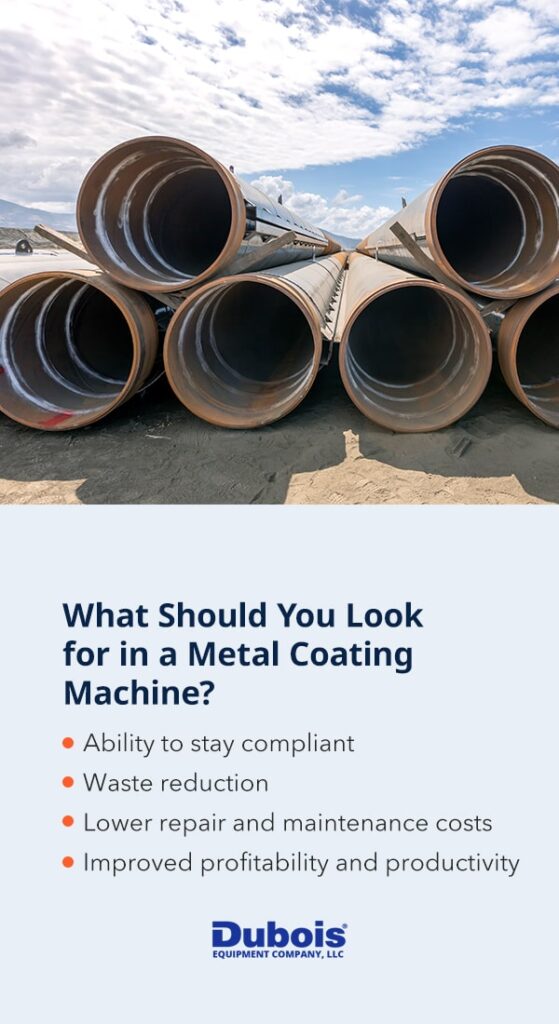
When choosing between pipe coating materials suppliers, you should know what to look for in a coating machine:
When you choose a coating machine from Dubois Equipment, you can enjoy all of these benefits of pipe coating equipment. Our products are also incredibly flexible, and the high-quality materials we use in every product ensure you can rely on a machine for years.
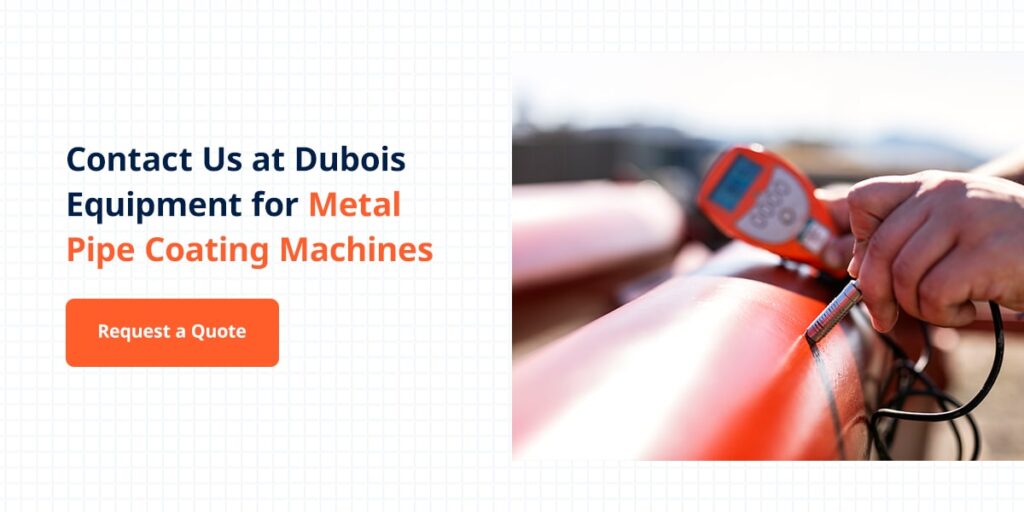
As a pipe coating materials company, Dubois Equipment understands the pipe coating process and can supply you with the finishing equipment you need. Our customized material finishing systems are made in the U.S. and include curing ovens, sanding machines and coating machines. We can customize finishing systems for wood, metal and specialty applications and design entire finishing lines or a single machine. With more than 50 years of experience, our team of highly skilled engineers can develop and manufacture complete solutions that meet your finishing needs.
If you’re a production line engineer or industrial coating operator looking to learn more about steel pipe coating specifications, contact us at Dubois Equipment or request a quote for a variety of protective coating machines.